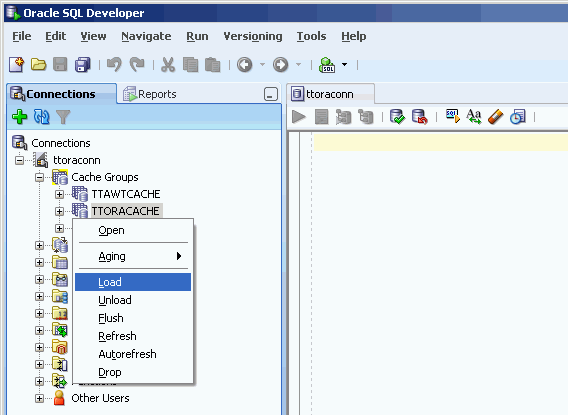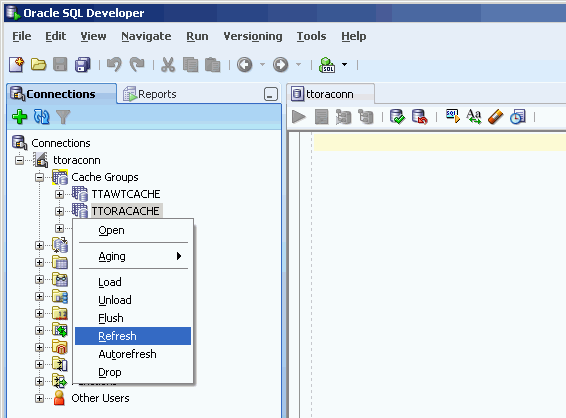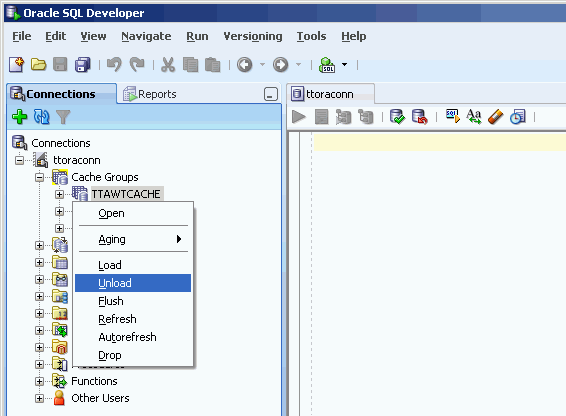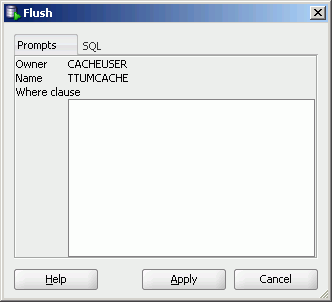4 Cache Group Operations
After you have created a cache group, you can perform operations to load, refresh, unload or flush the cache group depending on the cache group type.
Load or refresh a cache group
Click the + to the left of the Cache Groups node to view the list of cache groups. Next right-click the name of the cache group that you want to load or refresh. Then select Load to load the cache group or Refresh to refresh the cache group.


The cache agent must be running in order to load or refresh a cache group. See "Start and stop the cache agent" for information about how to start the cache agent.
For a read-only cache group or a user managed cache group that has automatic refresh defined, its automatic refresh state must be set to Paused before you can load or refresh the cache group. For information about changing the automatic refresh state of a cache group, see "Alter the automatic refresh attributes of a cache group".
In the Prompts tab of the Load or Refresh dialog box, specify a numeric value in the Commit every n rows field to indicate the frequency, based on the number of rows that are loaded or refreshed into the cache group, at which a commit is issued during the load or refresh operation. By default, a transaction is committed after every 256 rows are loaded or refreshed into the cache group.


In the Number of threads to run in parallel field within the Prompts tab of the Load or Refresh dialog box, specify the number of cache agent process threads to spawn and use for the load or refresh operation. Parallel processing of the load or refresh operation can potentially improve the operation's throughput. The numeric value specified in this field cannot exceed 10 and should not exceed the number of CPUs on the system that can be dedicated to the parallel load or refresh operation. The default value of 1 indicates that the load or refresh operation will be processed serially. For more information about parallel loading or refreshing of cache groups, see "Improving the performance of loading and refreshing a large number of cache instances" in the Oracle In-Memory Database Cache User's Guide or "Improving performance of loading and refreshing large tables" in the TimesTen Cache Connect to Oracle Guide.
You can specify an optional WHERE clause for the load or refresh operation in the Where clause field within the Prompts tab of the Load or Refresh dialog box. A WHERE clause is only allowed for a load or refresh operation on an AWT, SWT or user managed cache group that does not have automatic refresh defined. For more information about specifying a WHERE clause in a load or refresh operation, see "Loading and refreshing a cache group" in the Oracle In-Memory Database Cache User's Guide or the TimesTen Cache Connect to Oracle Guide.
Click the Apply button to load or refresh the cache group.
For more information about loading or refreshing a cache group, see "Loading and refreshing a cache group" in the Oracle In-Memory Database Cache User's Guide or the TimesTen Cache Connect to Oracle Guide.
Unload a cache group
Click the + to the left of the Cache Groups node to view the list of cache groups. Next right-click the name of the cache group that you want to unload. Then select Unload to unload the cache group.

In the Prompts tab of the Unload dialog box, you can specify an optional WHERE clause for the unload operation in the Where clause field. A WHERE clause is only allowed for an unload operation on an AWT, SWT or user managed cache group that does not have automatic refresh defined.
Click the Apply button to unload the cache group.

For more information about unloading a cache group, see "Unloading a cache group" in the Oracle In-Memory Database Cache User's Guide or the TimesTen Cache Connect to Oracle Guide.
Flush a cache group
Only user managed cache groups containing cache tables that are not all read-only, or not all updatable where updates on the tables are to be propagated to its corresponding Oracle tables can be flushed.
Click the + to the left of the Cache Groups node to view the list of cache groups. Next right-click the name of the cache group that you want to flush. Then select Flush to flush the cache group.

In the Prompts tab of the Flush dialog box, you can specify an optional WHERE clause for the flush operation in the Where clause field.
Click the Apply button to flush the cache group.

For more information about flushing a cache group, see "Flushing a user managed cache group" in the Oracle In-Memory Database Cache User's Guide or "Flushing a USERMANAGED cache group" in the TimesTen Cache Connect to Oracle Guide.